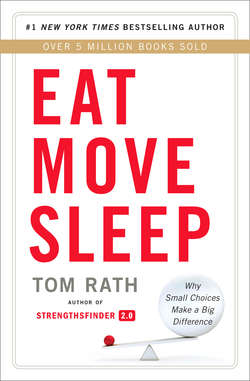Читать книгу Eat Move Sleep - Tom Rath - Страница 12
На сайте Литреса книга снята с продажи.
ОглавлениеOne Good Choice at a Time
3
What Counts More Than Calories
Reading a nutritional label and focusing on calories alone will lead you astray. While 9 percent of people read nutritional labels regularly, just 1 percent read beyond the headline of total calories.
Instead of focusing on total calories, another simple way to screen all the options you see in a day is to look at the ratio of carbs to protein. Set a goal of eating foods that have a ratio of one gram of carbs for every one gram of protein. I started doing this several years ago, and it is a great shortcut when scanning items in a grocery store or restaurant. Almost every nutritional label I’ve found lists both the total carbohydrates and total protein. For example, the mixed nuts I snack on regularly, the avocado salad I order for lunch, and my favorite Indian meal (palak paneer) all sit right at or near a 1 to 1 ratio.
At a minimum, avoid foods with a ratio higher than 5 to 1 carbs to protein. Most snack chips and cereals have a 10 to 1 ratio. Maintaining a better balance of carbohydrates to protein will give you additional energy while improving your health in the long run. Using this 1 to 1 ratio may not be the perfect metric for evaluating food, but it is a decent shortcut to ensuring that you are not overloading on carbs.
Use Product Placement at Home
If produce is hidden in a drawer at the bottom of your refrigerator, these good foods are out of sight and mind. The same holds true for your pantry. I used to have a shelf lined with salty crackers and chips at eye level. When these were the first things I noticed, they were my primary snack foods. That same shelf is now filled with healthy snacks, which makes good decisions easy.
Foods that sit out on tables and countertops are even more critical. When you see food every time you walk by, it gives you permission to graze. So to improve your choices, leave good foods like apples and pistachios sitting out instead of crackers and candy.
Go through the places in your house where you store food. Organize items so the best choices are the first things you see and the easiest to reach. Then hide poor choices in inconvenient places where you might not see them for a while. Better yet, simply clean house and discard foods with little nutritional value you know you’ll be tempted to eat.
Move fruits, vegetables, and other healthy options closer to eye level in your refrigerator or put them out on a counter. Simply seeing fresh produce regularly will plant a seed in your mind for your next snack. This also gives you a head start at resisting temptation in the moment.
Work Faster While You Walk
Working on this book was an experiment in itself. I decided to build a workstation on my treadmill and set a goal of writing this entire book while walking. So I mounted my computer monitor above my treadmill and built a homemade keyboard tray across the arm rests. Because it was a low-cost solution, I figured it was worth trying even if it did not work out.
After using this homemade walking desk for several months, I am now walking an additional 5–10 miles per day as a result. At the end of each “walk day,” as I have started to call it, my back no longer aches. I also have dramatically more energy compared with days when I am sitting in meetings, cars, or airplanes.
If it is remotely practical, try something like this to increase activity, even if it’s only when you are at home. I have a friend who forces himself to watch sporting events while on his elliptical machine so he gets a little activity alongside his favorite athletes. Another option is a standing desk or a convertible desk that moves up and down for standing and seated work.
If you stand still while you work, it is a good idea to alternate between standing and sitting. Standing still for extended periods can cause unnecessary strain if you don’t move around or alternate with sitting. You can also find adapters that secure to a stationary desk and allow you to raise and lower your monitor and keyboard to a standing or seated level.
All of these options are gaining popularity in workplaces as companies discover the cost savings from fewer sick days associated with excessive sitting. Several organizations I have worked with provide shared walking workstations where employees can go to catch up on email. I spoke with a friend the other day who used one of these shared workstations to complete all of his annual online compliance training.
If your employer will not provide walking or standing desks (it never hurts to ask), put your laptop or monitor on a shelf where you can stand and work occasionally. Or get a music stand, wall mount, or something that makes it easy to read and work while standing. At a minimum, try reading on a stationary bike, or take a walk while listening to an audio book or conference call.
Select one food to eat today with a balanced (1 to 1) ratio of carbs to protein. Avoid foods above a ratio of 5 to 1.
Put the healthiest foods in your home on a shelf at eye level or in a bowl on the counter.
Identify one way you can work without sitting, right now. Test it out tomorrow.
